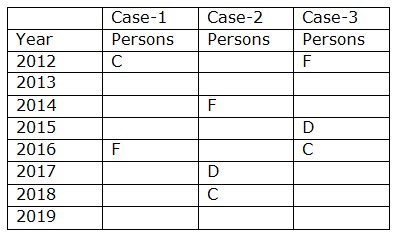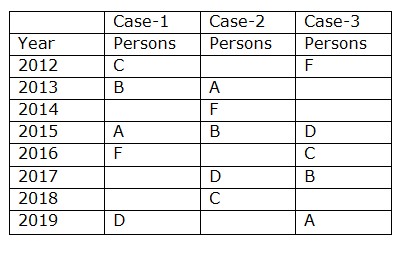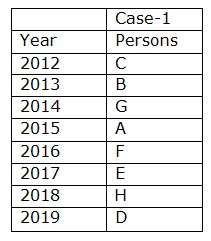Question
As many persons completed between D and B is same as
between H and ___. Study the following information carefully and answer the questions given below. Eight persons A, B, C, D, E, F, G and H completed Army training in eight different years viz. 2012 to 2019, but not necessarily in the same order. D completed the training three years after F. Only three persons completed the training between C and F. C doesn’t complete on an odd numbered year. The number of persons completed before D is one more than the number of persons completed after B. Only one person completed the training between B and A. The difference between the years in which G and E completed is three years. Both H and E completed the training in consecutive years.Solution
We have, D completed the training three years after F. Only three persons completed the training between C and F. C doesn’t complete on an odd numbered year. From the above condition, there are three possibilities  Again we have, The number of persons completed before D is one more than the number of persons completed after B. Only one person completed the training between B and A.
Again we have, The number of persons completed before D is one more than the number of persons completed after B. Only one person completed the training between B and A.  Again we have, The difference between the years in which G and E completed is three years. Both H and E completed the training in consecutive years. So Case2 and 3 get eliminated, hence the final arrangement becomes
Again we have, The difference between the years in which G and E completed is three years. Both H and E completed the training in consecutive years. So Case2 and 3 get eliminated, hence the final arrangement becomes 
Select the combination of letters that when sequentially placed in the blanks of the given letter series will complete the series.
p _ q q q _...
From the given alternatives select the word which cannot be formed using the letters of the given word
SIMULTANEOUSLY
The second number in the given pairs is obtained by performing some mathematical operation(s) on the first number. The same operation(s) is/are followed...
If all the letters in the word ‘LEAVING’ are arranged in alphabetical order from left to right such that the vowels are arranged first followed by...
How many alphabets are there between the 6th letter from the left end and 3rd letter from the right end after the rearrangement as...
How is V related to U’s mother?
If each letter in each of the word is arranged according to the alphabetical series, than which is the third letter of the word, which is fourth from th...
Select the number combination of letters that when placed sequentially in the blanks of the given series will complete the series.
G G G _ _ G H ...
Which one of the following will be the last but one when arranged according to the English Alphabetical Dictionary?
There are five student Z, V, T, J and H scored different marks. Z scores more than J but less than V. T scores less than V but more than H, who score mo...
Relevant for Exams:


